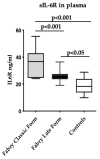Increased Soluble Interleukin 6 Receptors in Fabry Disease
- PMID: 38202225
- PMCID: PMC10780051
- DOI: 10.3390/jcm13010218
Increased Soluble Interleukin 6 Receptors in Fabry Disease
Abstract
Fabry disease (FD) is an X-linked lysosome storage disease that results in the accumulation of globotriaosylceramide (Gb3) throughout the body leading to irreversible target organ damage. As the role of secondary mediators (inflammatory molecules) and their mechanisms has not been fully elucidated, we focused on the interleukin (IL)-6 system in adult FD patients and in matched healthy subjects. To obtain insights into the complex regulation of IL-6 actions, we used a novel approach that integrates information from plasma and exosomes of FD patients (n = 20) and of healthy controls (n = 15). Soluble IL-6 receptor (sIL-6R) levels were measured in plasma with the ELISA method, and membrane-bound IL-6R was quantified in plasma and urinary exosomes using flow cytometry. In FD patients, the levels of soluble IL-6R in plasma were higher than in control subjects (28.0 ± 5.4 ng/mL vs. 18.9 ± 5.4 ng/mL, p < 0.0001); they were also higher in FD subjects with the classical form as compared to those with the late-onset form of the disease (36.0 ± 11.4 ng/mL vs. 26.1 ± 4.5 ng/mL, p < 0.0001). The percentage of urinary exosomes positive for IL-6R was slightly lower in FD (97 ± 1 vs. 100 ± 0% of events positive for IL-6R, p < 0.05); plasma IL-6 levels were not increased. These results suggest a potential role of IL-6 in triggering the inflammatory response in FD. As in FD patients only the levels of sIL-6Rs are consistently higher than in healthy controls, the IL-6 pathogenic signal seems to prevail over the homeostatic one, suggesting a potential mechanism causing multi-systemic damage in FD.
Keywords: Fabry disease; exosomes; inflammation; interleukin 6 receptor.
Conflict of interest statement
The authors declare no conflicts of interest.
Figures


References
-
- Tøndel C., Thurberg B.L., DasMahapatra P., Lyn N., Maski M., Batista J.L., George K., Patel H., Hariri A. Clinical Relevance of Globotriaosylceramide Accumulation in Fabry Disease and the Effect of Agalsidase Beta in Affected Tissues. Mol. Genet. Metab. 2022;137:328–341. doi: 10.1016/j.ymgme.2022.10.005. - DOI - PubMed
-
- Desnick R.J., Brady R., Barranger J., Collins A.J., Germain D.P., Goldman M., Grabowski G., Packman S., Wilcox W.R. Fabry Disease, an under-Recognized Multisystemic Disorder: Expert Recommendations for Diagnosis, Management, and Enzyme Replacement Therapy. Ann. Intern. Med. 2003;138:338–346. doi: 10.7326/0003-4819-138-4-200302180-00014. - DOI - PubMed
-
- Bertoldi G., Carraro G., Ravarotto V., Di Vico V., Baldini Anastasio P., Vitturi N., Francini F., Stefanelli L.F., Calò L.A. The Effect of Green Tea as an Adjuvant to Enzyme Replacement Therapy on Oxidative Stress in Fabry Disease: A Pilot Study. Front. Nutr. 2022;9:924710. doi: 10.3389/fnut.2022.924710. - DOI - PMC - PubMed
-
- Ravarotto V., Carraro G., Pagnin E., Bertoldi G., Simioni F., Maiolino G., Martinato M., Landini L., Davis P.A., Calò L.A. Oxidative Stress and the Altered Reaction to It in Fabry Disease: A Possible Target for Cardiovascular-Renal Remodeling? PLoS ONE. 2018;13:e0204618. doi: 10.1371/journal.pone.0204618. - DOI - PMC - PubMed
Grants and funding
LinkOut - more resources
Full Text Sources
Research Materials

